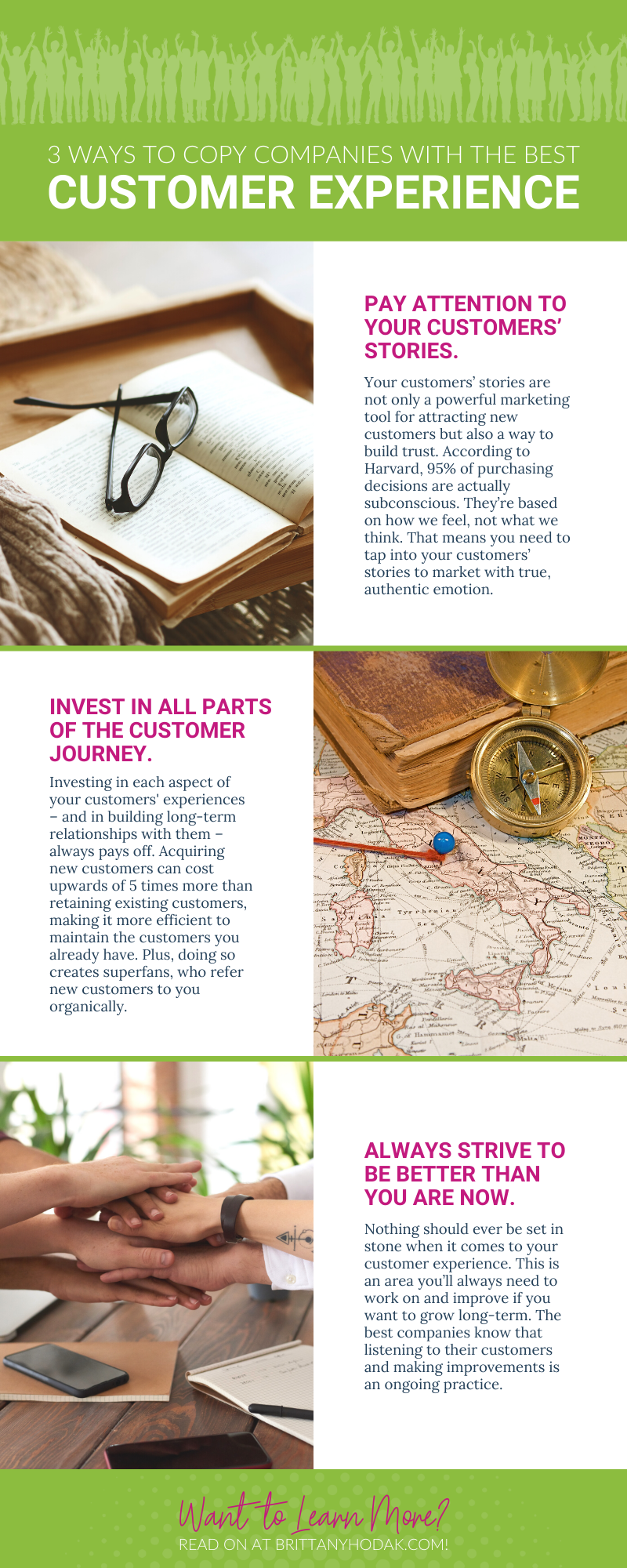When it comes to improving your brand’s customer experience, it helps to know the best path to take. Most customers know exactly what they want in terms of customer experience today, and that means their expectations (for companies with the best customer service) have never been higher.
In simple terms, customer experience refers to the interactions you have with your customers along the entire journey—from their first interaction with your brand to the last. While things like price, service, and marketing efforts all matter, they’re no longer the most important. In fact, a reported 67% of customers say that their standard for good customer service is higher than ever.
Luckily, you don’t have to reinvent the wheel. There are shining examples of companies that have mastered the customer-first experience. By learning from what they do right, you can transform your brand into a superfan machine. In this guide, we’ll explore 3 ways to copy companies with the best customer experience as well as the top examples to look towards now and in the future.
Pay attention to your customers’ stories.
First, your customers’ stories are worth their weight in gold. Not only are they a powerful marketing tool for attracting new customers, but they also help you grow. Your brand is only as successful as your best customers. By tapping into key stories, you can identify ways you need to improve and grow while also telling compelling stories.
People trust other people. While you might wish to sing your own praise from the rooftops, that will only get you so far. The phrase “show don’t tell” applies here. Saying that you’re a customer-first business is a great first step, but it doesn’t “prove” anything in reality. Instead, you need to highlight your customers’ stories in their own words.
In other words, the thing that sets stories apart from facts and figures is human emotion. Though we like to think we’re all rational, logical beings, research tells us otherwise. According to Harvard, 95% of purchasing decisions are actually subconscious. They’re based on how we feel, not what we think. That means you need to tap into your customers’ stories to market with true, authentic emotion.
Example #1: Starbucks
To start, let’s look at an example from the coffee giant Starbucks. Though Starbucks has endless statistics and figures to back up its coffee-making expertise, this isn’t what stands out. The thing that truly puts their marketing apart is their reliance on customers’ stories.
For example, the Starbucks “Every Name’s a Story Campaign” was so powerful that it won a diversity award in 2019. This British campaign is a mere 30 seconds long, yet it’s packed full of emotions. It follows the story of a young trans man who is constantly called the wrong name by everyone in his life. It isn’t until he visits his local Starbucks that he hears his real name, James, spoken for the first time. The emotion on his face is real and meaningful.
Viewers connect with James’ story and his struggle. They want to align themselves with a progressive, inspiring brand that understands everyone deserves the name of their choice. Though it might sound simple, this is highly effective. When customers consider where to buy their next latte, they’ll remember the feeling they had watching that campaign.
Example #2: Fenty Beauty
Next, let’s look at a beauty brand that made a name for itself in a competitive space. In the past, beauty brands boasted a limited range of skin colors for products like foundation, concealer, and so on. These brands weren’t listening to their customers’ stories. They weren’t responding to their real needs, and this left them struggling to find a place.
However, Rihanna’s beauty brand Fenty Beauty took the concerns of all women seriously. Their tagline is simple but effective: “Beauty For All.” By offering skin products in the largest spectrum of ranges, Fenty Beauty ensures nobody feels left out. Just by listening to the real-life stories of beauty consumers, this brand carved out space in a fast-paced, crowded industry.
This real-life connection paid off in a big way for the beauty brand. Despite existing in an extremely competitive $532 billion market, Fenty Beauty generated $100 million in its first 40 days. While much of this has to do with Rihanna’s face behind the brand, it’s much deeper than that. Other big-name stars have launched beauty brands, but this level of success was unprecedented.
By positioning itself as a diverse, inclusive brand for a diverse, inclusive base, they gained brand recognition amongst a huge underserved market who struggled to find their skin shade represented until now. See how listening to your customers takes you farther?
Invest in all parts of the customer journey.
Next, it’s easy for brands to focus too much attention on one aspect of the customer journey and forget about long-term relationships. Whether they focus on nurturing new customers or those just about to make a purchase, this alone isn’t enough. In order for a brand to truly shine, it needs to invest in all parts of the customer journey.
In other words, customer experience is never one-and-done. It’s an ongoing evolution, involving each interaction between the brand and the customer. Long-term relationships are incredibly valuable to businesses. Acquiring new customers can cost upwards of 5 times more than retaining existing customers. Not only is it more efficient to maintain the customers you already have, but it’s cheaper. This is also how you create raving superfans, those who will refer new customers into your business organically.
Example #1: Disney Theme Parks
The first example of a company that knows how to invest in every part of the customer journey is the Walt Disney Resort theme parks. Though there are a number of well-known theme parks across the globe, none quite compare to Disney. This is a brand that invests in the customer journey not just during the actual vacation, but even years after it ends.
With programs like the Disney Vacation Club, Disney perfected the process of creating super loyal customers. How did they do it? The answer is simpler than you think. They deliver a high-quality guest experience to each and every person who visits their theme park. The fun doesn’t stop when you leave the Magic Kingdom. It continues at your resort, during your dining reservation, and even on the bus ride back to the airport.
This concept is called “optimizing the mundane.” By turning everyday things (waiting for the bus, asking for directions, eating a meal, etc.) into “magical” experiences, Disney creates lifelong connections with guests. It all goes back to the park’s 4 Keys for customer service success:
- Safety: Safety always comes first for both guests and cast members.
- Courtesy: Cast members are kind and respectful during each interaction.
- Showmanship: Every cast member is “on stage” in their role, ensuring they keep the magic alive even with little interactions.
- Efficiency: Lastly, it’s important for cast members to be efficient when delivering excellent service.
It’s this immersive, customer-first experience that puts Disney on top. Not only do they go out of their way to empower cast members to deliver top-notch customer service, but they make a Disney vacation a worthwhile investment in family fun. A reported 70% of first-time Disney visitors return to the parks again, making Disney the top player in the theme park industry.
Example #2: Target
Next, it’s hard to avoid the buzz around Target. Though just a big-box store, Target earned itself a cult following amongst people of all backgrounds. When compared with similar big-box stores, it’s easy to see what sets Target apart.
These stores, no matter which one you go to, are always clean, well-organized, and easy to navigate. Though they have similar products to their competitor Walmart, Target consistently comes out on top in terms of the customer experience. In fact, this customer experience is so well-known and studied that it’s even been called the “Target Effect.”
What is this magical “Target Effect?” It’s not a trick of the light—though they do have excellent in-store lighting. This effect actually is a result of the store’s smart layout. To start, most entrances feature a Starbucks, proven to establish a warm welcome. Then, by placing similar sections near each other, the store naturally guides customers along through their shopping trip (often through aisles they didn’t even plan to go down).
Unlike other big-name retailers, there’s no frustration or confusion with Target’s layout. Everything is organized and easy to find. According to NYU professor Priya Raghubir, you don’t typically regret buying things you found during these meandering trips. Hence the prevalence of Instagram accounts like @TargetDoesItAgain with 1.4 million followers.
Always strive to be better than you are now.
Last but not least, nothing should ever be set in stone when it comes to your customer experience. This is an area you’ll always need to work on and improve if you want to grow long-term. The best companies know that listening to their customers and making improvements is an ongoing practice.
We’ve all seen companies that failed to change. For example, look at home video stores like Blockbuster. Though these were once on top, they failed to adapt in terms of technology and customer expectations. Now, they’re just a forgotten novelty in the ever-growing business graveyard. Ultimately, it takes constant evolution to keep moving forward.
Example #1: Sephora
One example of a company that isn’t afraid of change is the makeup retailer Sephora. We can all relate to the uncomfortable feeling of being approached again and again in a store by customer service staff asking if we need help. No matter how many times we say no, it’s sometimes only natural for them to linger and ask again.
Sephora recognized many customers were frustrated with this, especially those who enjoyed shopping solo. What’s the fix? A Sephora store in Europe started offering shoppers different colored baskets. A red basket indicates you’d like assistance while a black basket shows that you’d rather shop on your own.
Though simple, this color-coded system was a huge hit online. Brands need to realize that just because something worked in the past doesn’t mean it’s guaranteed to work in the future. It’s up to their leadership to advocate for changing customer expectations and needs.
Example #2: Netflix
Last but not least, the streaming service Netflix is a prime example of a company that’s not afraid to innovate. As one of the pioneers in the world of online streaming, Netflix started as a platform for streaming other film and TV network’s content. While that worked for a little while, it wasn’t enough on its own.
To offer users more streaming options, Netflix began rapidly creating its own content. From TV shows to Oscar-nominated films, they truly created something for all viewers. Some have even begun to argue that there are too many options, but Netflix has a solution for that too. The newest “Shuffle” feature debuts in 2021, and it chooses exactly what you should watch based on its complex algorithm and your watch history.
Ultimately, Netflix has proven it’s only going up. With over 200 million paid members, 37 million of which subscribed in the past year, it’s disrupted the entertainment industry for good. More and more people are making the (permanent) switch from cable, and there is no going back.
Inspiration Takes Your Business Further
In conclusion, when it comes to improving your customer experience as a brand, it’s intimidating to take action. This is especially true if you plan to disrupt an industry to create real change. Luckily, these pioneers above prove that it doesn’t take reinventing the wheel to impress your customers. As long as you’re in-tune with their needs and prepared to advocate for them, you’re on the right path.
Brands don’t develop superfans overnight. This is something that’s earned through trust, innovation, and progress. By telling your customers’ stories and keeping their needs first, you’ll always rise above the competition.






